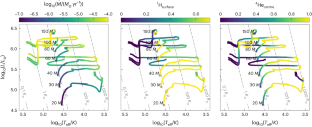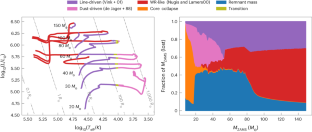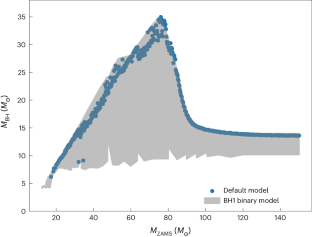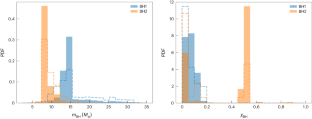Abstract
Gravitational-wave astronomy has revealed a population of stellar-mass black holes more massive than observed previously by other means. The maximum mass of black holes formed in isolated binaries is determined by stellar winds, mixing processes and interactions between the binary components. We consider the impact that fully self-consistent, detailed stellar-structure and binary-evolution calculations have on the population synthesis of black-hole binaries at solar metallicity. We find a qualitatively different picture from previous studies employing rapid population-synthesis techniques. Merging binary black holes form with a non-negligible rate (\(\sim 4\times 1{0}^{-7}\,{M}_{\odot }^{-1}\)) and their progenitor stars with initial masses ≳50 M⊙ do not expand to supergiant radii, thereby largely avoiding substantial dust-driven or luminous blue variable winds. The progenitor stars lose less mass in winds, which results in black holes as massive as ~30 M⊙, and approximately half avoid a mass-transfer episode before forming the first-born black hole. Binaries with initial periods of a few days, some of which may undergo Roche-lobe overflow mass transfer, result in mildly spinning first-born black holes, χBH1 ≲ 0.2, assuming efficient angular-momentum transport.
This is a preview of subscription content, access via your institution
Access options
Access Nature and 54 other Nature Portfolio journals
Get Nature+, our best-value online-access subscription
$29.99 / 30 days
cancel any time
Subscribe to this journal
Receive 12 digital issues and online access to articles
$119.00 per year
only $9.92 per issue
Buy this article
- Purchase on Springer Link
- Instant access to full article PDF
Prices may be subject to local taxes which are calculated during checkout




Similar content being viewed by others
Data availability
The source and Supplementary Data used in the main manuscript and Supplementary Discussion are publicly available on Zenodo65. The dataset includes all single-stellar model variations discussed in the manuscript and the BBH population synthesis model that can be used to reproduce our results. Additionally, POSYDON v.1.0 single and binary grid datasets can be found on Zenodo66.
Code availability
The POSYDON v.1.0 software used to generate the BBH population synthesis and single-stellar models is open source and is available on GitHub67. Additionally, the software used to compute double compact object merger rates and to generate the intrinsic and detectable BBH observable distributions in Fig. 4 is available on GitHub68.
References
Corral-Santana, J. M. et al. BlackCAT: a catalogue of stellar-mass black holes in X-ray transients. Astron. Astrophys. 587, A61 (2016).
Tetarenko, B. E., Sivakoff, G. R., Heinke, C. O. & Gladstone, J. C. WATCHDOG: a comprehensive all-sky database of galactic black hole X-ray binaries. Astrophys. J. Suppl. Ser. 222, 15 (2016).
Abbott, B. P. et al. Observation of gravitational waves from a binary black hole merger. Phys. Rev. Lett. 116, 061102 (2016).
Abbott, R. et al. GWTC-2.1: deep extended catalog of compact binary coalescences observed by LIGO and Virgo during the first half of the third observing run. Preprint at https://doi.org/10.48550/arXiv.2108.01045 (2021).
Abbott, R. et al. GWTC-3: compact binary coalescences observed by LIGO and Virgo during the second part of the third observing run. Preprint at https://doi.org/10.48550/arXiv.2111.03606 (2021).
Giesers, B. et al. A stellar census in globular clusters with MUSE: binaries in NGC 3201. Astron. Astrophys. 632, A3 (2019).
El-Badry, K. et al. A Sun-like star orbiting a black hole. Mon. Not. R. Astron. Soc. 518, 1057–1085 (2023).
Miller-Jones, J. C. A. et al. Cygnus X-1 contains a 21-solar mass black hole—implications for massive star winds. Science 371, 1046–1049 (2021).
Belczynski, K., Holz, D. E., Bulik, T. & O’Shaughnessy, R. The first gravitational-wave source from the isolated evolution of two stars in the 40-100 solar mass range. Nature 534, 512–515 (2016).
Abbott, B. P. et al. Astrophysical Implications of the binary black-hole merger GW150914. Astrophys. J. Lett. 818, L22 (2016).
Asplund, M., Grevesse, N., Sauval, A. J. & Scott, P. The chemical composition of the Sun. Annu. Rev. Astron. Astrophys. 47, 481–522 (2009).
Vink, J. S., de Koter, A. & Lamers, H. J. G. L. M. Mass-loss predictions for O and B stars as a function of metallicity. Astron. Astrophys. 369, 574–588 (2001).
Nugis, T. & Lamers, H. J. G. L. M. Mass-loss rates of Wolf–Rayet stars as a function of stellar parameters. Astron. Astrophys. 360, 227–244 (2000).
Meynet, G., Maeder, A., Schaller, G., Schaerer, D. & Charbonnel, C. Grids of massive stars with high mass loss rates. V. From 12 to 120 M⊙ at Z=0.001, 0.004, 0.008, 0.020 and 0.040. Astron. Astrophys. Suppl. 103, 97–105 (1994).
Smith, N. Mass loss: its effect on the evolution and fate of high-mass stars. Annu. Rev. Astron. Astrophys. 52, 487–528 (2014).
Renzo, M., Ott, C. D., Shore, S. N. & de Mink, S. E. Systematic survey of the effects of wind mass loss algorithms on the evolution of single massive stars. Astron. Astrophys. 603, A118 (2017).
Belczynski, K. et al. The formation of a 70 M⊙ black hole at high metallicity. Astrophys. J. 890, 113 (2020).
Vink, J. S. Theory and diagnostics of hot star mass loss. Annu. Rev. Astron. Astrophys. 60, 203–246 (2022).
Chiosi, C. & Maeder, A. The evolution of massive stars with mass loss. Annu. Rev. Astron. Astrophys. 24, 329–375 (1986).
Maeder, A. & Meynet, G. Grids of evolutionary models of massive stars with mass loss and overshooting – properties of Wolf-Rayet stars sensitive to overshooting. Astron. Astrophys. 182, 243–263 (1987).
Hurley, J. R., Tout, C. A. & Pols, O. R. Evolution of binary stars and the effect of tides on binary populations. Mon. Not. R. Astron. Soc. 329, 897–928 (2002).
Breivik, K. et al. COSMIC variance in binary population synthesis. Astrophys. J. 898, 71 (2020).
Riley, J. et al. Rapid stellar and binary population synthesis with COMPAS. Astrophys. J. Suppl. Ser. 258, 34 (2022).
Belczynski, K., Kalogera, V. & Bulik, T. A comprehensive study of binary compact objects as gravitational wave sources: evolutionary channels, rates, and physical properties. Astrophys. J. 572, 407–431 (2002).
Hurley, J. R., Pols, O. R. & Tout, C. A. Comprehensive analytic formulae for stellar evolution as a function of mass and metallicity. Mon. Not. R. Astron. Soc. 315, 543–569 (2000).
Pols, O. R., Schröder, K.-P., Hurley, J. R., Tout, C. A. & Eggleton, P. P. Stellar evolution models for Z = 0.0001 to 0.03. Mon. Not. R. Astron. Soc. 298, 525–536 (1998).
Agrawal, P., Hurley, J., Stevenson, S., Szécsi, D. & Flynn, C. The fates of massive stars: exploring uncertainties in stellar evolution with METISSE. Mon. Not. R. Astron. Soc. 497, 4549–4564 (2020).
Romagnolo, A. et al. The role of stellar expansion on the formation of gravitational wave sources. Preprint at https://doi.org/10.48550/arXiv.2211.15800 (2022).
Paxton, B. et al. Modules for experiments in stellar astrophysics (MESA): pulsating variable stars, rotation, convective boundaries, and energy conservation. Astrophys. J. Suppl. Ser. 243, 10 (2019).
Fragos, T. et al. POSYDON: a general-purpose population synthesis code with detailed binary-evolution simulations. Astrophys. J. Suppl. Ser. 264, 45 (2023).
Dominik, M. et al. Double compact objects. II. Cosmological merger rates. Astrophys. J. 779, 72 (2013).
Neijssel, C. J. et al. The effect of the metallicity-specific star formation history on double compact object mergers. Mon. Not. R. Astron. Soc. 490, 3740–3759 (2019).
Broekgaarden, F. S. et al. Impact of massive binary star and cosmic evolution on gravitational wave observations - II. Double compact object rates and properties. Mon. Not. R. Astron. Soc. 516, 5737–5761 (2022).
Ekström, S. et al. Grids of stellar models with rotation. I. Models from 0.8 to 120 M⊙ at solar metallicity (Z = 0.014). Astron. Astrophys. 537, A146 (2012).
Choi, J. et al. Mesa isochrones and stellar tracks (MIST). I. Solar-scaled models. Astrophys. J. 823, 102 (2016).
Smith, N. Luminous blue variables and the fates of very massive stars. Philos. Trans. R. Soc. A 375, 20160268 (2017).
Patton, R. A. & Sukhbold, T. Towards a realistic explosion landscape for binary population synthesis. Mon. Not. R. Astron. Soc. 499, 2803–2816 (2020).
Dorozsmai, A. & Toonen, S. Importance of stable mass transfer and stellar winds for the formation of gravitational wave sources. Preprint at https://doi.org/10.48550/arXiv.2207.08837 (2022).
van den Heuvel, E. P. J., Portegies Zwart, S. F. & de Mink, S. E. Forming short-period Wolf-Rayet X-ray binaries and double black holes through stable mass transfer. Mon. Not. R. Astron. Soc. 471, 4256–4264 (2017).
Bavera, S. S. et al. The origin of spin in binary black holes. Predicting the distributions of the main observables of Advanced LIGO. Astron. Astrophys. 635, A97 (2020).
Bavera, S. S. et al. The impact of mass-transfer physics on the observable properties of field binary black hole populations. Astron. Astrophys. 647, A153 (2021).
Nelson, D. et al. The illustris simulation: public data release. Astron. Comput. 13, 12–37 (2015).
Aasi, J. et al. Advanced LIGO. Class. Quantum Gravity 32, 074001 (2015).
Bavera, S. S. et al. Probing the progenitors of spinning binary black-hole mergers with long gamma-ray bursts. Astron. Astrophys. 657, L8 (2022).
Graham, J. F., Schady, P. & Fruchter, A. S. A surprising lack of LGRB metallicity evolution with redshift. Preprint at https://doi.org/10.48550/arXiv.1904.02673 (2019).
Farr, W. M. et al. Distinguishing spin-aligned and isotropic black hole populations with gravitational waves. Nature 548, 426–429 (2017).
Misra, D. et al. X-ray luminosity function of high-mass X-ray binaries: studying the signatures of different physical processes using detailed binary evolution calculations. Astron. Astrophys. 672, A99 (2023).
Rout, S. K., Vadawale, S., Garćia, J. & Connors, R. Revisiting the galactic Xray binary MAXI J1631-479: implications for high inclination and a massive black hole. Astrophys. J. 944, 68 (2023).
Breivik, K., Chatterjee, S. & Larson, S. L. Revealing black holes with Gaia. Astrophys. J. Lett. 850, L13 (2017).
Callister, T. A., Miller, S. J., Chatziioannou, K. & Farr, W. M. No vvidence that the majority of black holes in binaries have zero spin. Astrophys. J. Lett. 937, L13 (2022).
Paxton, B. et al. Modules for experiments in stellar astrophysics (MESA). Astrophys. J. Suppl. Ser. 192, 3 (2011).
Paxton, B. et al. Modules for experiments in stellar astrophysics (MESA): planets, oscillations, rotation, and massive stars. Astrophys. J. Suppl. Ser. 208, 4 (2013).
Paxton, B. et al. Modules for experiments in stellar astrophysics (MESA): binaries, pulsations, and explosions. Astrophys. J. Suppl. Ser. 220, 15 (2015).
Paxton, B. et al. Modules for experiments in stellar astrophysics (MESA): convective boundaries, element diffusion, and massive star explosions. Astrophys. J. Suppl. Ser. 234, 34 (2018).
de Jager, C., Nieuwenhuijzen, H. & van der Hucht, K. A. Mass loss rates in the Hertzsprung-Russell diagram. Astron. Astrophys. Suppl. 72, 259–289 (1988).
Humphreys, R. M. & Davidson, K. The luminous blue variables: astrophysical geysers. Publ. Astron. Soc. Pac. 106, 1025 (1994).
Belczynski, K. et al. On the maximum mass of stellar black holes. Astrophys. J. 714, 1217–1226 (2010).
Fryer, C. L. et al. Compact remnant mass function: dependence on the explosion mechanism and metallicity. Astrophys. J. 749, 91 (2012).
Abbott, B. P. et al. Prospects for observing and localizing gravitational-wave transients with Advanced LIGO, Advanced Virgo and KAGRA. Living Rev. Relativ. 21, 3 (2018).
Barrett, J. W. et al. Accuracy of inference on the physics of binary evolution from gravitational-wave observations. Mon. Not. R. Astron. Soc. 477, 4685–4695 (2018).
Ng, K. K. Y. et al. Gravitational-wave astrophysics with effective-spin measurements: asymmetries and selection biases. Phys. Rev. D 98, 083007 (2018).
LIGO Algorithm Library – LALSuite (LIGO Scientific Collaboration, 2018).
Finn, L. S. & Chernoff, D. F. Observing binary inspiral in gravitational radiation: one interferometer. Phys. Rev. D 47, 2198–2219 (1993).
Aasi, J. et al. Search of the Orion spur for continuous gravitational waves using a loosely coherent algorithm on data from LIGO interferometers. Phys. Rev. D 93, 042006 (2016).
Bavera, S. S. Dataset associated to the publication NATASTRON- 22125961A arXiv:2212.10924. Zenodo https://doi.org/10.5281/zenodo.7965618 (2023).
Fragos, T. Posydon data. Zenodohttps://doi.org/10.5281/zenodo.6655751 (2022).
POSYDON Collaboration. Posydon. (GitHub, accessed 6 Febuary 2023) https://github.com/POSYDON-code/POSYDON
Bavera, S. S. Binary black hole merger rates. (GitHub, accessed 24 May 2023) https://github.com/ssbvr/BBH_merger_rates
Hunter, J. D. Matplotlib: a 2d graphics environment. Comput. Sci. Eng. 9, 90–95 (2007).
Price-Whelan, A. M. et al. The astropy project: building an open-science project and status of the v2. 0 core package. Astron. J. 156, 123 (2018).
Pérez, F. & Granger, B. E. IPython: a system for interactive scientific computing. Comput. Sci. Eng. 9, 21–29 (2007).
Harris, C. R. et al. Array programming with NumPy. Nature 585, 357–362 (2020).
pandas-dev/pandas: Pandas. Zenodo https://doi.org/10.5281/zenodo.7344967 (The pandas development team, 2022).
Virtanen, P. et al. SciPy 1.0: fundamental algorithms for scientific computing in Python. Nat. Methods 17, 261–272 (2020).
Acknowledgements
The POSYDON project is supported primarily by two sources: the Swiss National Science Foundation Professorship grant (PI Fragos, project numbers PP00P2_176868 and PP00P2_211006) and the Gordon and Betty Moore Foundation (PI Kalogera, grant award GBMF8477). S.S.B., T.F., D.M. and E.Z. were supported by the project PP00P2_176868 and S.S.B., T.F., M.K. and Z.X. were supported by the project number PP00P2_211006. Z.X. was also supported by the Chinese Scholarship Council (CSC). E.Z. acknowledges funding support from the European Research Council (ERC) under the European Union’s Horizon 2020 research and innovation programme (Grant agreement No. 772086). V.K., A.D., K.A.R., P.M.S. and M.S. were supported by the project number GBMF8477. C.P.L.B. acknowledges support from the University of Glasgow. K.K. acknowledges support from the Federal Commission for Scholarships for Foreign Students for the Swiss Government Excellence Scholarship (ESKAS no. 2021.0277) and the Spanish State Research Agency, through the María de Maeztu Program for Centers and Units of Excellence in R&D, no. CEX2020-001058-M. K.A.R. also thanks the LSSTC Data Science Fellowship Program, funded by LSSTC, NSF Cybertraining grant no. 1829740, the Brinson Foundation and the Moore Foundation; their participation in the programme has benefited this work. The computations were performed at Northwestern University on the Trident computer cluster (funded by the GBMF8477 award) and at the University of Geneva on the Yggdrasil computer cluster. This research was partly supported by the computational resources and staff contributions provided for the Quest high-performance computing facility at Northwestern University, jointly supported by the Office of the Provost, the Office for Research and Northwestern University Information Technology. All figures were made with the open-source Python module Matplotlib69. This research used the Python modules Astropy70, iPython71, Numpy72, Pandas73 and SciPy74.
Author information
Authors and Affiliations
Contributions
All authors contributed to the work presented in this paper. S.S.B. led the writing with substantial contributions from T.F., E.Z., J.J.A., V.K., C.P.L.B. and M.K. The results presented in this study were obtained using the open-source software POSYDON, which was developed by S.S.B., T.F., J.J.A., E.Z., A.D., K.K., D.M., K.A.R., P.M.S., M.S. and Z.X.
Corresponding author
Ethics declarations
Competing interests
The authors declare no competing interests.
Peer review
Peer review information
Nature Astronomy thanks the anonymous reviewers for their contribution to the peer review of this work.
Additional information
Publisher’s note Springer Nature remains neutral with regard to jurisdictional claims in published maps and institutional affiliations.
Supplementary information
Supplementary Information
Supplementary Figs. 1–6 and Discussion.
Rights and permissions
Springer Nature or its licensor (e.g. a society or other partner) holds exclusive rights to this article under a publishing agreement with the author(s) or other rightsholder(s); author self-archiving of the accepted manuscript version of this article is solely governed by the terms of such publishing agreement and applicable law.
About this article
Cite this article
Bavera, S.S., Fragos, T., Zapartas, E. et al. The formation of merging black holes with masses beyond 30 M⊙ at solar metallicity. Nat Astron 7, 1090–1097 (2023). https://doi.org/10.1038/s41550-023-02018-5
Received:
Accepted:
Published:
Issue Date:
DOI: https://doi.org/10.1038/s41550-023-02018-5



